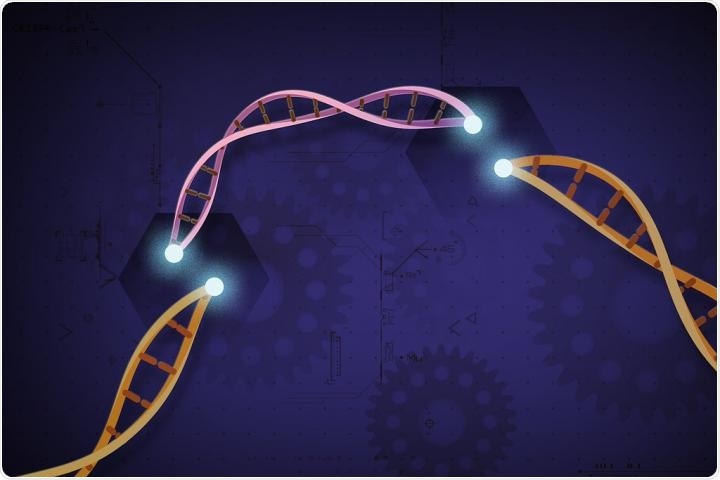Yiping Qi, an associate professor of Plant Science from the University of Maryland, continues to create new genome editing and engineering in plants, with the ultimate objective of enhancing the efficiency of food production. The study was recently published in the Nature Communications journal.

Associate professor of Plant Science at the University of Maryland Yiping Qi continues to innovate genome editing and engineering in plants, with the ultimate goal of improving the efficiency of food production. His new work contributes six novel variants of CRISPR-Cas12a in plants, testing first in rice as a major global crop. In addition to broadening possible gene editing targets, these tools can edit many different sites at once, or even repress gene expression. Image Credit: National Institutes of Health, public domain.
Qi’s most recent study provides six new CRISPR-Cas12a variants that have never been demonstrated in plants before, evaluating them first in rice which is a major global crop.
Apart from enabling a relatively wider range of potential gene editing targets. the new tools can instantly edit several different sites in the genome and also suppress the expression of genes to reduce undesirable characteristics.
These patent-pending tools significantly extend the scope of what CRISPR-Cas12a can do in plants, potentially allowing for more efficient production of food to feed the world’s rising population.
We are excited about this paper because we've contributed two major breakthroughs. First, we've reported multiple Cas12a tools with genome editing capabilities in plants for the first time, and found one [Mb2Cas12a] that hugely broadens the targeting range of Cas12a. Second, we've developed a very efficient system that can edit many different sites at once [multiplexed editing], and that allows us to edit 16 different genes in rice in a single generation.”
Yiping Qi, Associate Professor of Plant Science, University of Maryland
Cas12a, similar to other CRISPR systems, has traditionally been linked to targeting a particular short sequence of DNA, called the PAM sequence, explained Qi. CRISPR systems generally use the PAM sequence to determine the site to potentially make their molecular cuts in DNA.
But Qi’s novel Mb2Cas12a variant functions under relaxed PAM conditions, extending the scope of what can be targeted for editing the same way as Qi’s laboratory recently did for CRISPR-Cas9.
Apart from this latest finding, the multiplexed editing system developed for Cas12a in plants offers particular strategies to efficiently edit numerous sites across the genome at the same time. For this proof-of-concept, Qi’s research team initially focused on six different genomic sites to improve disease resistance and rice yield. But once this was accomplished, the researchers did not stop there.
I wanted to add more targets to see if there is any limit. So we added 10 more and tried to target 16 sites, and we found that across almost all rice chromosomes, we had an amazingly high efficiency with all sites being edited all at once in one generation. And that doesn't even represent the upper limit necessarily, but it is the most genes in a plant that has ever been recorded as being edited all at once in one generation for Cas12a.”
Yiping Qi, Associate Professor of Plant Science, University of Maryland
According to Qi, this system holds important implications for the efficiency of food production and precision breeding.
For precision breeding, how many genes you can edit at once is really practically important because you can target almost anything and really tailor the product. We targeted disease resistance and yield, but you can add more traits like nitrogen use efficiency, climate resilience traits such as temperature tolerance, and more. It is really a robust system.”
Yiping Qi, Associate Professor of Plant Science, University of Maryland
Qi is presently investigating the off-targeting impacts of editing additional genes at once with less stringent target site criteria. However, apart from these contributions, the article demonstrated the usefulness of Cas12a as a synthetic repressor of genes in the Arabidopsis model plant as another tool for genome engineering.
“You can regulate activation or repression of certain genes by using CRISPR not as a cutting tool, but instead as a binding tool to attract activators or repressors to induce or suppress gene expression to engineer desirable traits. In this case, Cas12a is acting as glue, not as scissors. You use an inactivated form of Cas12a to inactivate the expression of other genes. It's a great new tool for the industry and for future research,” added Qi.
Upcoming studies will extend the Cas12a tools beyond rice and Arabidopsis to include all types of crops and plants.
“This type of technology helps increase crop yield and sustainably feed a growing population in a changing world. I am very pleased to continue to expand the impacts of CRISPR technologies,” concluded Qi.
Source:
Journal reference:
Zhang, Y., et al. (2021) Expanding the scope of plant genome engineering with Cas12a orthologs and highly multiplexable editing systems. Nature Communications. doi.org/10.1038/s41467-021-22330-w.